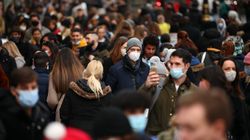A new and more infectious strain of Covid-19 has forced Boris Johnson into a dramatic last-minute rethink of Christmas rules.
London and huge areas of the south east and east of England will face the biggest disruption with a new and tougher tier 4 local lockdown enforced in law from midnight tonight.
Here’s everything you need to know as head for a very different Christmas.
What are the restrictions in tier 4?
All non-essential shops, gyms and leisure facilities, hairdressers and salons will close from 00.01 Sunday.
This is in addition to hospitality venues already being closed.
People are ordered to stay at home and this instruction is being enshrined in law.
Tier 4 will not be part of the Christmas bubble policy. Household mixing indoors is strictly prohibited and only one person can meet up with one other outdoors.
Travel is also restricted unless for essential work purposes, childcare or healthcare.
Nobody can travel in or outside of tier 4 unless essential. No tier 4 resident can stay overnight away from their own home.
Nurseries and places of worship will remain open. Schools are not affected as they have already closed for the Christmas break.
The support bubble policy for single person households still applies.
Tier 4 measures will be reviewed after two weeks, so will be in place until at least December 30.
Which areas are in the new tier 4?
All areas of England which were this week moved from tier 2 into tier 3 restrictions will go into tier 4. These are:
-
All of London
-
Kent
-
Buckinghamshire
-
Berkshire
-
Surrey (excluding Waverley)
-
The boroughs of Gosport, Havant, Portsmouth, Rother and Hastings
-
Bedford
-
Central Bedfordshire
-
Milton Keynes
-
Luton
-
Peterborough
-
Hertfordshire
-
Essex (excluding Colchester, Uttlesford and Tendring).
The area accounts for around 15 million people or a third of the population of England.
Christmas in tiers 1, 2 and 3 – what has changed?
Three households are able to form a Christmas bubble but for just one day on December 25.
Previously this policy had been over five days, from December 23 to December 27, in England.
Scotland, Wales and Northern Ireland are reviewing their plans.
Why is this happening?
The government is deeply worried about the spread of the virus and a new and more infectious variant.
Boris Johnson has said the new strain may be up to 70% more transmissible and could increase the R value by 0.
On Friday, the R rate jumped above the crucial number 1 and is now 1.1-1.2, having been 0.9-1 the previous week.
If Covid-19 is able to spread, it could have a devastating impact it could have on the NHS in the depths of winter.
Chief medical officer Chris Whitty says that the New and Emerging Respiratory Virus Threats Advisory Group (NERVTAG) has judged the new strain of the virus to be more infectious.
The new variant accounts for 60% of the disease’s spread in the areas being placed into tier 4.
There has also been a 66% rise in case rates and in London the pandemic has almost doubled in the space of seven days.
Whitty says the World Health Organisation has been alerted to the impact of the new strain, which has so far only been seen in a handful of cases in two other countries.
“There is no current evidence to suggest the new strain causes a higher mortality rate or that it affects vaccines and treatments although urgent work is underway to confirm this,” he said.
“Given this latest development it is now more vital than ever that the public continue to take action in their area to reduce transmission.”


